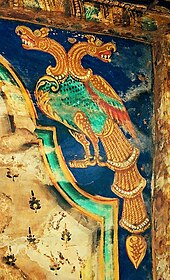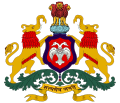Gandaberunda


The Gandaberunda or Berunda (Kannada: ಗಂಡಭೇರುಂಡ gaṇḍabheruṇḍa), or Bheruṇḍa (Sanskrit: भेरुण्ड, lit. terrible) is a two-headed bird in Hindu mythology, believed to possess immense magical strength. It is a form of Vishnu to fight Sharabha, a form of Shiva created to destroy Vishnu's lion-man Narasimha avatar.
It was the emblem of the erstwhile Kingdom of Mysore under the Wodeyar kings, and after India attained independence, it was retained by Mysore state as its emblem. That state was enlarged in 1956 and renamed Karnataka in 1973, and the Gandabherunda continues to be the official state emblem of Karnataka. It is used as the official emblem of the Karnataka state government because it is a symbol of strength. It is believed to be capable of fighting the forces of destruction. It appears as an intricately carved sculpture motif in Hindu temples.[1]
Depiction[]
The bird is generally depicted as clutching elephants in its talons and beaks, demonstrating its immense strength. In a coin [Kasu] found in Madurai, it is shown holding a snake in its beak.[2] All 2-dimensional depictions show a symmetrical image similar to the Double-headed eagle while other images show the long tail feathers resembling a peacock. In the Chennakeshava temple of Belur, Karnataka, Gandaberunda, the two faced bird is carved as a scene of "chain of destruction" result in destruction of Universe.[3] The Gandaberunda was later identified as a physical form displayed by Narasimha, Man-Lion avatar of Vishnu. It's mentioned by several Hindu scriptures.

After Narasimha had slain the demon Hiranyakashipu. he drank the demon's blood; his anger did not subside. The gods (devas) fearing that he will destroy the cosmos in his fury, asked the god Shiva for help. In order to protect the entire creation, Shiva sent his Virabhadra form to ask Narasimha to cool down, but Narasimha ignored this appeal. So Shiva incarnated as Sharabha or Sharabheswara, a part-lion and part-bird beast which outclassed Narasimha both in structure and power. Then, Sharabha held Narasimha and began carrying him high up in the sky, during which Narasimha created a two-headed Eagle - Gandaberunda - who was even stronger than Sharabha with his rage. Sharabha took Narasimha to the highest altitude and was about to toss him. At this time, Narasimha snapped out of his fury and became calm. Narasimha then, prayed to Sharabha to forgive him. As a mark of respect to Shiva, Narasimha removed the skin of lion from his body and presented to Sharabha, who later pacified Narasimha. Both Shiva and Vishnu then returned to their abode. However, Gandaberunda rose and began the hunt for Sharabha. Finally when Gandaberunda met Sharabha, a fierce 18 day long battle took place between them. On the 18th day, Gandhaberunda defeated Sharabha in battle.
Usage[]
A sculpture depicting a Gandaberunda is found on the roof of the Rameshwara temple in the temple town of Keladi in Shimoga District, the capital of the Keladi Nayakas. The Gandaberunda was also used by the Wodeyar dynasty of Mysore as the Royal emblem. The Karnataka Government adopted this symbol as the state symbol and can be found on bus terminals and tickets issued by Karnataka State Road Transport Corporation. Coins(Gold pagoda or gadyana) from the rule of Achyuta Deva Raya are thought to be the first to use the Gandaberunda on currency.[4] The crest of the Indian navy ship INS Mysore (D60) features a Gandaberunda.
In media[]
Ganda Berunda is a Kannada film directed by S. V. Rajendrasingh Babu and produced by Vajramuni. The playwright of the movie was the celebrated writer, late H V Subba Rao. The film was released in the year 1984. The music was composed by Sathyam. Bollywood actor Amrish Puri played the antagonist in the film.
The Gandaberunda emblem in the Mysore Palace.

Coat of arms of Karnataka, India

Gandaberunda image seen at Lalitha Mahal Palace Hotel, Mysore
See also[]
Notes[]
- ^ "Mystical Bird Gandaberunda". Retrieved 2007-04-12.
- ^ Ganesh Coins of Tamilnadu, 13.48
- ^ "Kamat's Potpourri: Amma's Column - Gandaberunda- The Two Headed Bird". 2014-02-02. Archived from the original on 2014-02-02. Retrieved 2020-01-23.
- ^ "The COININDIA Coin Galleries: Vijayanagar". coinindia.com. Retrieved 2020-01-23.
1.Brahma took the avatar of Gandaberunda & not vishnu[clarification needed]
External links[]
| Wikimedia Commons has media related to Gandaberunda. |
- "Evolution of Gandabherunda"-article by S. Srikanta Sastri
- http://digitalcommons.unl.edu/cgi/viewcontent.cgi?article=1001&context=iqsc4symp
- A unique sculpture of Gandaberunda or berunda from Balligavi: [1]
- Legendary birds
- Hindu legendary creatures
- Heraldic birds
- Indian legendary creatures
- Forms of Vishnu


